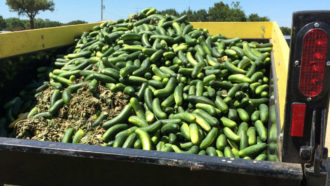RALEIGH, North Carolina – For farmers concerned about food waste on the farm, North Carolina State University researchers are developing tools and other educational resources that would help farmers calculate on-farm produce losses and then find ways to bring those products to market.
In a newly funded Southern Sustainable Agriculture Research & Education Grant (LS17-280), “A Supply Chain Approach to Finding Win-win Sustainable Solutions for Edible But Unharvested Produce,” social scientist and agricultural economist Rebecca Dunning and her colleagues are taking a supply chain approach to identifying economically efficient ways to minimize production loss and, in turn, augment farm revenues.
The research is an expansion of a SSARE Graduate Student Grant (GS15-142), “Food Waste: Quantifying on-farm vegetable losses,” in which researchers developed a protocol to help farmers better quantify vegetable losses, specifically squash and cucumbers. The research results found that food waste on the farm is much higher than industry estimates; on one farm evaluated, for example, approximately 57 percent of edible produce was left on the fields -- roughly 7,800 pounds of vegetables that went unharvested.
Two videos have been developed based on the Graduate Student Grant results to help farmers estimate their own on-farm losses:
Finding Opportunity in the Field: Estimating losses to improve yield, Cucumbers
Finding Opportunity in the Field: Estimated losses to improve yield, Sweet potatoes
The goal of the current grant project is to create market opportunities for edible and nutritious produce that can be harvested, but don’t meet industry grade standards. One of the objectives of the study is to work with producer buyers, processors, food service and other alternate markets to identify scenarios to bring unharvested produce to market. In one example, researchers are testing a concept of connecting farmers to a food service company that requires a percentage of its produce to be obtained locally, while connecting the food service company to local chefs who are open to using imperfect produce.
Researchers have developed a website, Whole Crop Harvest, to communicate the progress of the research to its readers. In addition, they have created a bulletin, “How to Determine the Potential to Increase Vegetable Yield Through Estimating and Reducing Field Losses,” as a guide for farmers to increase produce quality and yield.
Researchers have completed the first year of the two-year project.
Published by the Southern Region of the Sustainable Agriculture Research and Education (SARE) program. Funded by the USDA National Institute of Food and Agriculture (NIFA), Southern SARE operates under cooperative agreements with the University of Georgia, Fort Valley State University, and the Kerr Center for Sustainable Agriculture to offer competitive grants to advance sustainable agriculture in America's Southern region. This material is based upon work that is supported by the National Institute of Food and Agriculture, U.S. Department of Agriculture, through Southern Sustainable Agriculture Research and Education, under sub-award numbers: LS17-280 and GS15-142. USDA is an equal opportunity employer and service provider. Any opinions, findings, conclusions, or recommendations expressed in this publication are those of the author(s) and do not necessarily reflect the view of the U.S. Department of Agriculture.
